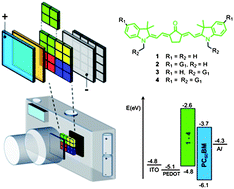Accurate colour reproduction by image sensors requires four narrow-band absorbing photodetectors (blue, green, yellow and red), and this is generally achieved by using a broadband photodetector and colour filters. We have developed an organic photodetector in which colour selection is achieved by the light-absorbing layer of the detector. The photoactive layer is comprised of a green absorbing ketocyanine dye-cored dendrimer with the dendrons providing solution processability and prevention of aggregation in the solid-state, which can otherwise lead to the broadening of the absorption spectrum. The properties of the photoactive dendrimer were found to be dependent on the attachment point and number of dendrons. The best photodetector contained a bulk heterojunction (BHJ) light-absorbing layer comprised of the dendrimer with two first generation biphenyl-based dendrons attached to the nitrogen atoms of the ketocyanine dye blended with [6,6]-phenyl-C61-butryic acid methyl ester (PC60BM). The photodetector had a Full Width at Half Maximum (FWHM) of the response of 130 nm centred around 500 nm, an External Quantum Efficiency (EQE) of 8.2% at −1 V and the largest rectification ratio (2.7 × 104 at 0 V) so far reported for a green-absorbing organic photodetector. The performance of the photodetector was found to be approaching that required for current machine vision systems.

You have access to this article
 Please wait while we load your content...
Something went wrong. Try again?
Please wait while we load your content...
Something went wrong. Try again?


 Please wait while we load your content...
Please wait while we load your content...